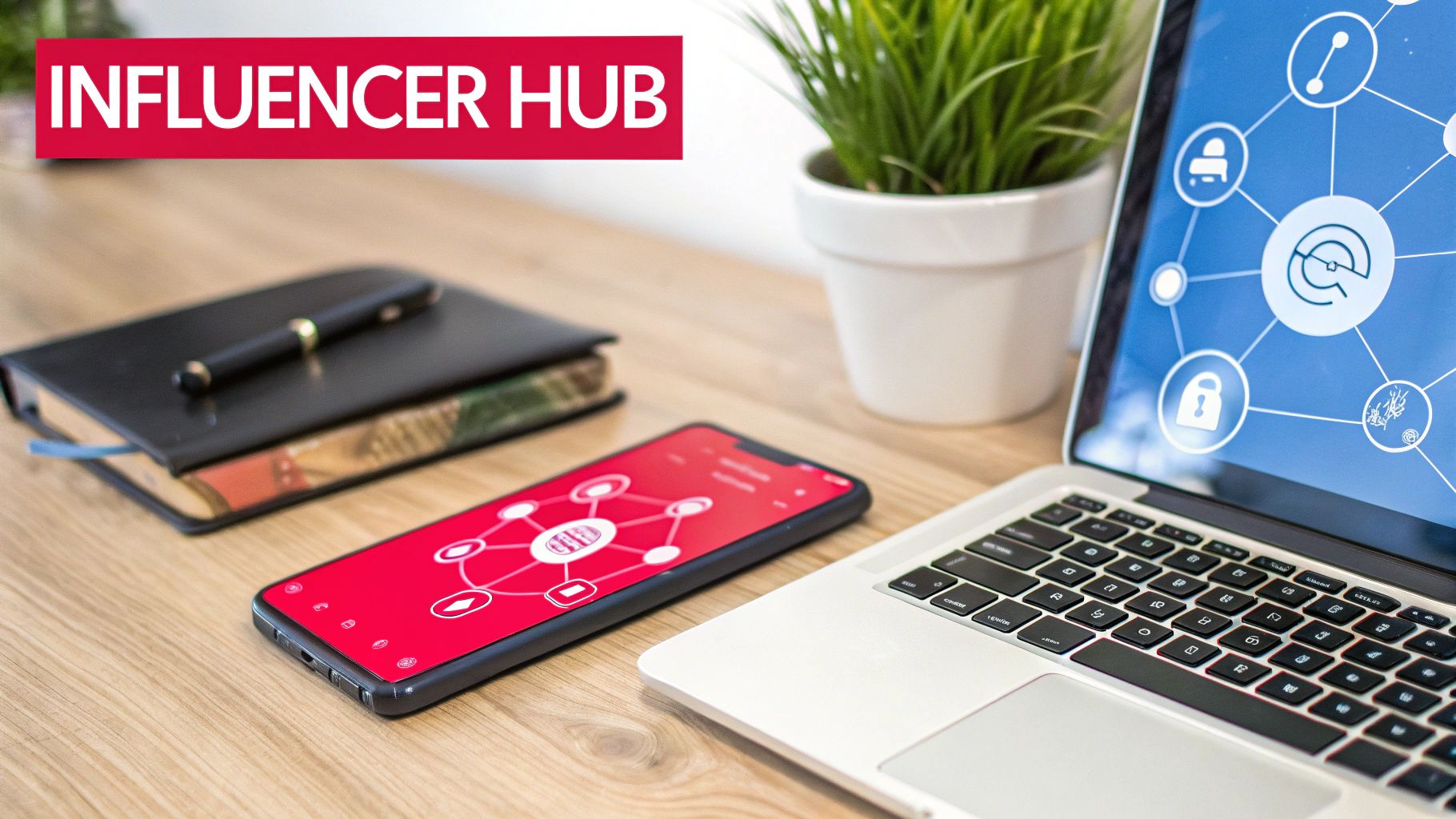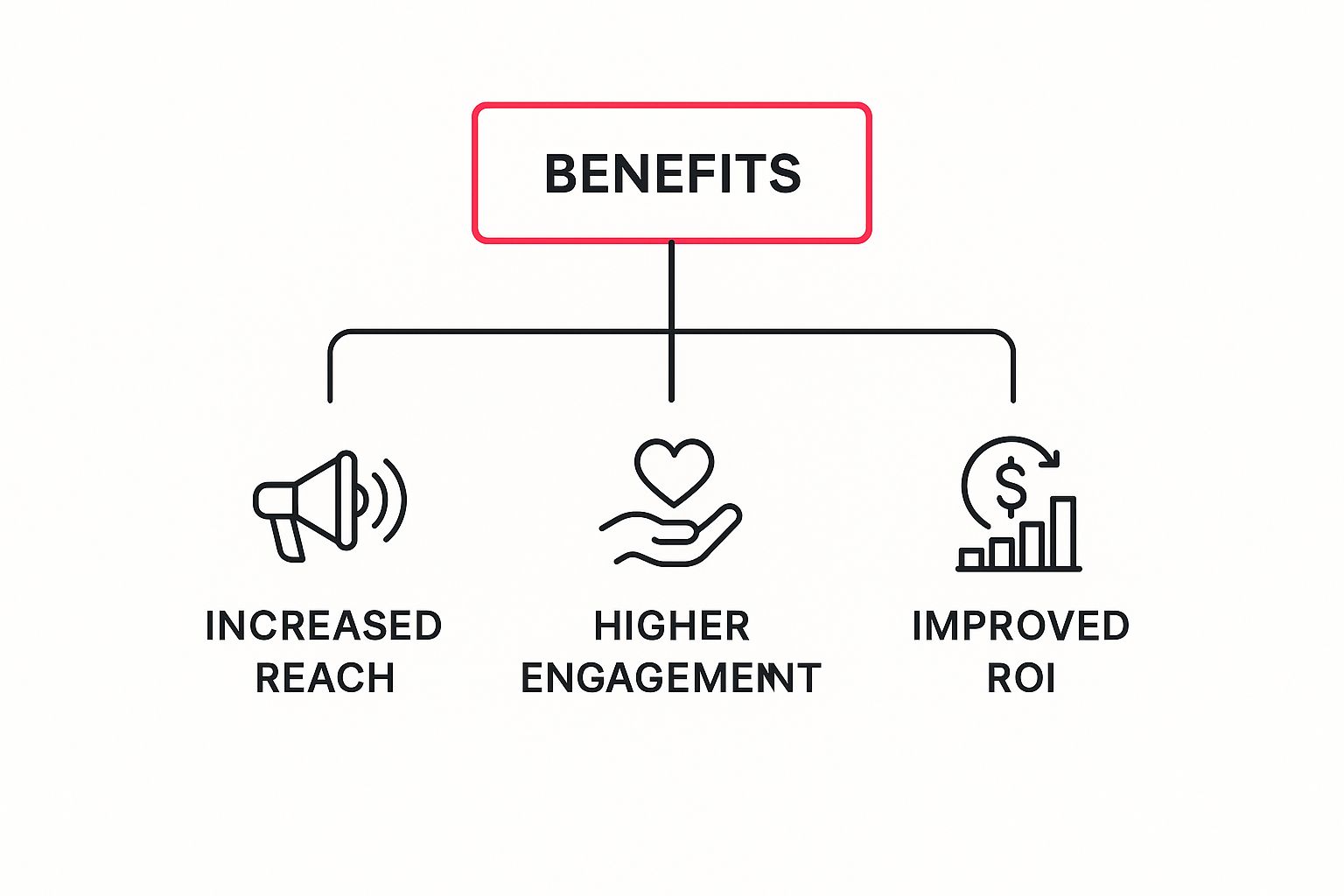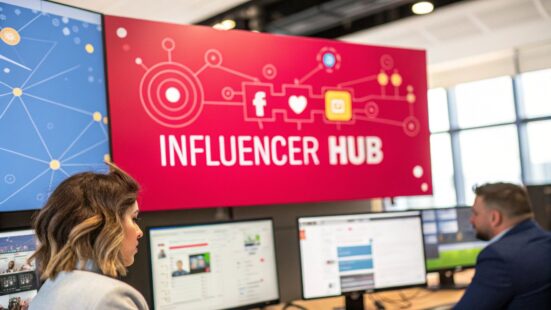 Master Content Marketing Attribution for Better ROI
Master Content Marketing Attribution for Better ROI
Think about managing a busy airport without an air traffic control tower. It would be pure chaos. Planes (your campaigns) would be flying everywhere with zero coordination, communication would break down, and you’d have no real way of knowing what was going on.
That’s pretty much what managing influencer marketing manually feels like—a jumbled mess of spreadsheets, email threads, and a half-dozen different tools that don't talk to each other.
What Is an Influencer Marketing Hub?
An influencer marketing hub is the air traffic control tower for your brand. It’s a centralized software platform that brings order, visibility, and control to what can otherwise be an incredibly fragmented process.

Instead of juggling countless spreadsheets for tracking influencers, using separate systems for payments, and getting lost in endless email chains for content approvals, a hub pulls everything together into one unified command center.
This centralized approach isn’t just a nice-to-have anymore; it’s becoming essential. The global influencer marketing industry is exploding, with projections showing it will hit a market size of around $32.55 billion by 2025. That's a staggering growth rate of 35.63% from 2024, which explains why over 80% of marketers see it as a powerful strategy. If you want to dive deeper into the numbers, the latest influencer marketing benchmark report has some great insights.
From Chaos to Cohesion
At its core, a hub shifts your entire workflow from reactive to proactive. You’re no longer just putting out fires. You have an integrated system that supports every single stage of your creator partnerships, from the first moment of discovery to the final payment and performance review.
This table shows just how big of a difference a centralized hub can make compared to the old, manual ways of doing things.
Manual Methods vs. Centralized Hub
| Function | Traditional Method (Manual) | Influencer Marketing Hub (Centralized) |
|---|---|---|
| Discovery | Scrolling social media, keyword searches, relying on existing networks. Slow and often surface-level. | AI-powered search filters, audience analytics, and a vetted creator database. Fast and data-driven. |
| Communication | Endless email threads, DMs, and text messages. Disorganized and hard to track. | Built-in messaging, automated notifications, and a single communication record for each campaign. |
| Campaign Management | Complex spreadsheets, multiple documents for briefs, and manual deadline tracking. Prone to errors. | Automated workflows, campaign templates, and real-time progress dashboards. Organized and efficient. |
| Content Approvals | Emailing files back and forth, confusing feedback loops, and version control nightmares. | A unified workflow where creators submit content for review, feedback, and approval in one place. |
| Payments | Manual invoicing, individual bank transfers, and difficult payment tracking. Time-consuming. | Automated, one-click payments, contract management, and integrated tax forms. |
| Analytics & ROI | Manually compiling data from different platforms, using UTM codes, and struggling to prove ROI. | Real-time dashboards, automated reports, and clear measurement of reach, engagement, and ROI. |
As you can see, a hub eliminates the administrative bottlenecks that not only slow down your campaigns but also make it nearly impossible to see what's actually working.
By bringing every function under one roof, an influencer marketing hub gets rid of the guesswork. It gives you a single source of truth for your entire program, so you always know where you stand.
Ultimately, this integrated system is what allows you to scale your efforts effectively. It doesn’t matter if you’re working with five creators or five hundred—the hub provides the structure you need to maintain control, protect your brand, and make decisions based on real data.
It’s the foundational technology that separates brands that merely dabble in influencer marketing from those that build powerful, sustainable creator communities for the long haul.
Table of Contents
Exploring the Core Components of a Hub
To really get what an influencer marketing hub is all about, you have to look under the hood. It’s less like a single tool and more like a high-performance team with specialized departments, each built to handle a critical piece of your creator strategy. All these parts work together, turning what’s often a chaotic, manual mess into a smooth, well-oiled machine.
At its core, a hub is designed to optimize one of the most vital parts of the job: streamlining how brands handle their influencer relationship management strategies. It's this all-in-one approach to management that truly sets a hub apart from simpler, one-off tools.
The Talent Scouting Department
First up, and arguably the most important function, is influencer discovery and vetting. This is your in-house talent scouting department, and its only job is to find the perfect partners for your brand. We’ve all been there—endlessly scrolling through social media, hoping to stumble upon the right person. It's slow, and honestly, it's a terrible way to build a reliable strategy.
A hub completely changes the game by giving you a powerful, searchable database of creators. Instead of just chasing follower counts, you can get incredibly specific with your search.
- Audience Demographics: Find creators whose followers actually match your ideal customer, filtering by age, location, and interests.
- Performance Metrics: Go beyond vanity metrics and look at what really matters—engagement rates, past campaign results, and audience authenticity.
- Niche and Content Style: Pinpoint creators who are already making content that fits your brand’s look and feel.
This data-first approach ensures you’re partnering with people who can deliver real impact, not just a big number with an irrelevant audience.
The Operations and Legal Department
Once you’ve found your ideal influencers, the real admin headache begins. This is where the hub’s operations and legal features kick in, automating all those tedious tasks that can drain your team’s time and energy.
Think about it. Managing contracts, negotiations, and payments for a dozen different creators through email threads and bank transfers is a nightmare waiting to happen. It's a recipe for mistakes and frustrating delays. A hub centralizes all of this with automated workflows for everything from digital agreements and tax forms to payment schedules.
This frees up your team from drowning in paperwork, letting them focus on what they do best: building strong, authentic relationships with creators.
A great influencer marketing hub doesn't just find you creators; it builds the entire operational scaffolding needed to manage those partnerships at scale, from the initial contract to the final payment.
The Creative Studio
Next, you have the creative process itself. Here, the hub acts as your creative studio, giving you a single, shared space for campaign briefs and content approvals. The endless back-and-forth of emailing content drafts and feedback is notoriously inefficient and almost always leads to crossed wires.
A hub fixes this with a dedicated portal where you can:
- Share Detailed Briefs: Make sure every creator is on the same page with goals, key messages, and deliverables right from the start.
- Review Submitted Content: Creators upload their work directly to the platform for your team to check.
- Provide Clear Feedback: Leave time-stamped comments and revision requests right on the content itself. No more "in the third video, at the 15-second mark…" emails.
This streamlined workflow keeps your branding consistent and helps you and your partners create amazing content, faster.
The Business Intelligence Department
Finally, how do you know if any of this is actually working? The hub’s performance analytics and reporting features act as your business intelligence department. Manually pulling metrics from five different social platforms is a huge time-sink, and it rarely gives you the full story.
This infographic breaks down the primary benefits a hub drives, which are all measured by this analytics component.

As the visual shows, a well-run program delivers tangible results like more reach, better engagement, and a solid return on your investment.
A hub automates all of this with real-time dashboards that track your key performance indicators (KPIs) across every single campaign. You can easily measure reach, engagement, conversions, and—most importantly—calculate a clear return on investment (ROI). This makes reporting on your success to stakeholders simple and proves the value of your marketing spend.
Each component builds on the last, creating a powerful, integrated system that manages the entire influencer marketing lifecycle from start to finish.
The True Benefits of Centralizing Your Strategy
Bringing your influencer marketing into a central hub does more than just clean up your messy spreadsheets. It's about fundamentally rewiring how your brand operates, turning what was once a chaotic, time-sucking process into a well-oiled machine built for growth. The real-world advantages are tangible, touching everything from daily productivity to your long-term brand reputation and, most importantly, your bottom line.

Think about reclaiming all those hours your team currently loses to mind-numbing administrative work. One of the biggest wins from centralizing your influencer marketing is the massive productivity boost you’ll see. A proper hub helps you improve workflow efficiency across every single campaign, freeing up your team to focus on what actually moves the needle: strategy and relationship-building.
Gain Streamlined Efficiency
Without a central system, your team is probably stuck in a loop of tedious, manual tasks. Does tracking influencer conversations across a dozen emails and DMs, processing invoices one by one, or chasing creators for content approvals sound familiar? Each of these little jobs adds up, creating a huge drain on your time and energy.
An influencer marketing hub automates these exact pain points. For instance, instead of you having to remember to send payments, the platform can trigger them automatically the moment a creator’s content gets the green light. This doesn't just save you time—it builds stronger relationships by making sure your partners are paid promptly and professionally.
Make Smarter Decisions with Real-Time Data
One of the greatest frustrations with manual, disconnected methods is the complete lack of real-time visibility. You might launch a campaign and not find out until weeks later that a specific creator or message is falling flat. By then, it's too late to pivot, and you've already burned through a chunk of your budget.
A hub gives you a live dashboard that acts as your campaign’s mission control. You can watch key metrics like engagement rates, reach, and click-throughs roll in as they happen.
If you spot one influencer's content knocking it out of the park, you can immediately put more resources behind it to amplify its success. This ability to optimize on the fly is what separates high-performing programs from stagnant ones.
This pivot to data-driven agility isn't just a nice-to-have; it's essential. Brands are projected to spend a whopping $9.29 billion on influencer campaigns globally in 2025, which is a 14.2% jump from 2024. And with nearly a quarter of marketers already putting over 40% of their total budget into influencers, making smart, informed decisions is no longer a choice.
Achieve Accurate ROI Measurement
Proving the value of your influencer marketing program is often the hardest part. How do you draw a straight line from a series of Instagram posts to a bump in sales? An influencer marketing hub makes this connection crystal clear and undeniable.
- Trackable Links: You can assign a unique, trackable link to every influencer, letting you see exactly how much traffic and how many sales each one drives.
- Discount Codes: Custom discount codes make it simple to attribute purchases directly back to specific creators.
- Integrated Analytics: The platform does the heavy lifting, pulling all this data together to calculate your exact return on investment (ROI) without you ever having to open a spreadsheet.
Suddenly, you can walk into that budget meeting with a clear, data-backed report showing that for every dollar spent on influencers, you generated a specific amount in revenue. This is how you transform influencer marketing from a perceived "expense" into a proven, powerful revenue driver for your business.
Ensure Effortless Scalability and Brand Safety
As your program gets bigger, so does the complexity. Managing five influencers is one thing, but managing fifty is a completely different ballgame. A hub provides the essential framework to scale your efforts without everything falling apart.
With standardized contracts, automated workflows, and a single place for all communication, you can maintain consistency and brand safety, no matter how many campaigns you're juggling. This system protects your brand by ensuring every creator agrees to the same terms and follows a clear content approval process, minimizing the risk of off-brand content or compliance headaches as you grow.
Picking the right influencer marketing hub is a lot like choosing the central operating system for your business—it has to match your specific workflow, budget, and goals. It's easy to get wowed by the most expensive platform with a mountain of features, but that's rarely the best choice. The real win is finding a "right-fit" solution that solves your biggest headaches and can grow with you.
You’ve got to look past the slick sales demos and start asking the tough questions. A great platform should feel like a natural extension of your team, not another complicated tool that just adds more work to your plate. It needs to click with what your brand is all about, whether you're a small e-commerce shop focused on user-generated content or a big agency juggling dozens of clients.
Define Your Core Needs and Priorities
Before you even glance at a single platform, take a step back and figure out what you're actually trying to accomplish. Are you drowning in admin tasks and desperate for automation? Are you finding it impossible to connect with authentic creators? Or is proving ROI to your leadership team the monster under your bed?
Start by making a list of your non-negotiables. Think of this internal audit as your compass; it'll guide you through the noise and stop you from getting distracted by flashy features you'll never use.
Consider these key areas:
- Team Size and Structure: How many people need access? Will you need different permission levels for managers, coordinators, and the finance team?
- Campaign Volume: Are you running a couple of campaigns a month or twenty? Your volume is a huge factor in the level of automation and scalability you'll need.
- Biggest Pain Points: Pinpoint the top three bottlenecks in your current process. Is it discovering creators, handling payments, getting content approved, or pulling reports?
Answering these questions first means you walk into every demo with a clear scorecard. You'll be ready to evaluate how each potential influencer marketing hub actually stacks up against what you truly need.
Key Evaluation Criteria for Any Hub
Once your internal priorities are set, you can start looking at platforms. While every brand has a unique wish list, there are some universal benchmarks you should use to measure any solution you're considering. These are the foundational pillars of a solid platform.
A platform's true value isn't just in its features, but in how seamlessly it fits into your daily grind and how well its creator network aligns with your brand's audience.
Here’s a breakdown of what to really dig into:
1. Quality of the Influencer Database
The heart of any hub is its network of creators. Don't get fooled by massive numbers alone—quality and relevance are what matter. A database of 250,000 highly engaged, vetted creators in your niche is way more valuable than a database with millions of inactive or off-brand accounts.
2. Depth of Analytics and Reporting
Your platform must be able to answer the most important question: "Is this actually working?" Look for customizable dashboards and real-time tracking of key metrics like engagement, reach, and conversions. Most importantly, you need to be able to easily generate reports that prove your ROI. Without strong analytics, you're just guessing.
3. Integration Capabilities
An influencer marketing hub can't live on an island. Check if it plays nicely with the other tools in your marketing stack. Can it connect to Shopify to track sales from creator codes? Does it integrate with Salesforce or other CRMs? Smooth integrations save a ton of time and give you a complete picture of your marketing performance.
4. Transparent Pricing Models
Pricing should be simple, predictable, and make sense for the value you're getting. Watch out for hidden fees, surprise upcharges for essential features, or confusing pricing tiers. Always ask for a detailed breakdown of what’s included in each plan to make sure it scales logically as your program grows. For instance, a platform like JoinBrands offers flexible plans designed for companies of all sizes, from startups just getting going to large, established agencies.
To help you compare your options, we've put together a simple checklist. Use this to grade each platform you evaluate against your specific needs, so you can see clearly which one comes out on top for your brand.
Platform Evaluation Checklist
| Evaluation Criteria | Platform A | Platform B | Your Needs |
|---|---|---|---|
| Creator Database Quality | Vetted creators in [Your Niche]? | ||
| Discovery & Search Filters | Search by demographics, engagement, etc.? | ||
| Campaign Management | Automated workflows, content approval? | ||
| Analytics & ROI Reporting | Customizable dashboards, sales tracking? | ||
| E-commerce Integrations | Shopify, WooCommerce, etc.? | ||
| CRM/Email Integrations | Salesforce, HubSpot, etc.? | ||
| Creator Communication Tools | In-app messaging, email templates? | ||
| Payment Processing | Automated, multi-currency support? | ||
| Content & Rights Management | Asset library, usage rights tracking? | ||
| Team Collaboration | User roles, permissions, notes? | ||
| Pricing Model | Fits budget, scalable, no hidden fees? | ||
| Customer Support | Dedicated manager, live chat, help docs? |
By systematically filling this out for each contender, you'll move beyond the sales pitch and make a data-driven decision. This simple exercise can be the difference between buying a tool and investing in a true partner for your brand's growth.
An influencer marketing hub is a powerful engine, but it won't drive itself. Getting this kind of tech humming requires a thoughtful, phased approach—not just flicking a switch and hoping for the best. If you treat implementation like a strategic project instead of a simple software rollout, you’ll unlock its full potential and get your whole team on board.
First things first: lay a solid foundation. That starts with a clean data migration. If you’ve been juggling spreadsheets to track creator contacts, campaign history, and payment info, now’s the time to get all of that into your new, centralized system. A clean start prevents a world of headaches down the road and makes sure your team trusts the data from day one.
Next up is the critical task of sorting out user roles and permissions.
Setting Up Your Team for Success
Think of your hub like a secure office building. Not everyone needs a key to every single room. Figuring out who can do what is essential for keeping things under control, protecting your brand, and making sure workflows actually flow.
Start by mapping out what everyone on your team actually does:
- Admins: These are usually your marketing leaders. They need the master key—full oversight, including access to billing, user management, and the big-picture analytics.
- Campaign Managers: These folks are in the trenches. They need to build campaigns, invite influencers, approve content, and track performance reports for the projects they own.
- Finance Team: Their access can be limited. They just need to get into the payment and invoicing features to handle creator compensation quickly and accurately.
- Legal Team: Give them a key that only opens the contract management door. They can pop in, review agreements, and get out without getting bogged down in campaign details.
By setting up these roles from the get-go, you ensure every team member sees only what's relevant to their job. It cuts down on the clutter, minimizes the risk of someone accidentally deleting a campaign, and makes the platform feel way less intimidating to new users.
Change management is the most overlooked part of any technology implementation. The best influencer marketing hub is useless if your team resists using it. Securing team-wide adoption is not just a goal; it's a prerequisite for success.
This brings us to the most human part of the process: getting your team excited. You have to sell them on the "why." Frame the hub as a tool that gets rid of their biggest headaches—no more chasing down invoices or digging through a hundred emails for one content draft. Run some dedicated onboarding sessions and create simple, internal "how-to" guides for the most common tasks.
Launching Your First Pilot Campaign
Okay, your data is in and your team is trained. Now it’s time to prove the hub’s value with a pilot campaign. Don't try to boil the ocean here. Pick a small, low-risk project to test out your new workflows in a real-world (but controlled) environment. This is where your team gets to learn the ropes without the pressure of a massive launch.
For your pilot, set some clear, realistic 90-day goals. These need to be specific and measurable so you can point to tangible proof of the hub's impact.
Your 90-day goals might look something like this:
- Reduce time spent on creator payments by 50% by using the automated payment tools.
- Decrease content approval time by 30% by keeping all feedback inside the platform.
- Launch one complete campaign—from finding influencers to final reporting—entirely within the hub.
- Achieve 100% team adoption for the pilot campaign, with every conversation and task logged in the system.
Nailing these early wins is huge. They create positive buzz and give you the hard data you need to build confidence across the company. When your team sees firsthand how the influencer marketing hub makes their jobs easier and delivers real results, they'll become its biggest fans. And that’s how you make sure it becomes a core part of your brand’s strategy for good.
The Future of Creator Partnerships and Technology
Influencer marketing hubs are already powerful command centers, but what’s next on the horizon? The platforms of tomorrow are evolving into something far more intelligent and deeply integrated. We're on the cusp of a major shift, and the future of creator partnerships will be shaped heavily by new tech like AI applications in digital marketing.

This evolution isn’t some far-off dream; it's already happening. Artificial intelligence is getting way smarter than just basic discovery filters. The next generation of hubs will use predictive analytics to forecast how well a campaign might do, pinpoint creators with a genuine love for your brand, and even flag potential risks before you even start a partnership.
The Rise of Creator Relationship Management
The biggest change we're seeing is the move away from one-off, transactional campaigns and toward building long-term creator communities. Hubs are morphing into true Creator Relationship Management (CRM) systems. Think less like a simple project management tool and more like Salesforce, but built from the ground up for your creator ecosystem.
The future of the influencer marketing hub is not about managing one-off campaigns. It's about nurturing an ecosystem of brand advocates who grow with you over time, driven by genuine loyalty rather than a single paycheck.
This is all about putting authenticity first and fostering growth that lasts. Instead of constantly hunting for new faces, brands will use their hub to build deeper connections with creators who not only get great results but actually love their products.
Seamless Integration with Social Commerce
Another huge trend is the fusion of influencer hubs and social commerce. Soon, these platforms will do more than just track posts and engagement. They will directly power "shop now" buttons right inside an influencer's content, creating a completely seamless path from discovery to purchase—all managed and measured within the hub.
- Direct Shoppable Links: Hubs will generate unique, trackable shopping links for every creator, tying their content directly to your checkout page.
- Live Shopping Integration: Platforms will offer tools to run and analyze live shopping events hosted by your influencers, a massive driver of modern e-commerce.
This convergence makes the influencer marketing hub an absolutely essential tool for any brand that's serious about creator-led growth. As the market continues to grow, these trends become even more important. Just look at the U.S., which currently accounts for 22.7% of all Instagram sponsored posts, or Brazil, home to a whopping 15.8% of the world's Instagram influencers. Understanding these dynamics is key to staying ahead.
Common Questions About Influencer Hubs
When you're thinking about bringing a new system into your workflow, you're going to have questions. That's natural. An influencer marketing hub is a big investment in your brand’s future, so let’s clear up some of the most common points of confusion to help you feel confident in your decision.
What Is the Difference Between a Database and a Hub?
This is a big one. It’s incredibly easy to mistake an influencer database for a full-fledged hub, but they are fundamentally different tools built for very different jobs.
Think of an influencer database as a digital phone book. It’s a list of creators you can search through, usually with some basic filters like follower count or niche. It’s useful for that first step—finding potential partners—but that's where its job ends. It gives you names, but it doesn't help you actually manage the relationship or the project itself.
An influencer marketing hub, on the other hand, is the entire office building. The database is just one room inside. A hub provides the complete, end-to-end infrastructure you need to run your entire program.
A database gives you a list; a hub gives you a complete operational system. It handles the entire campaign lifecycle, from discovery and contracting to content approvals, payments, and in-depth analytics.
Simply put, a hub takes a bunch of disconnected tasks and pulls them all together into a single, smooth workflow.
How Much Does an Influencer Marketing Hub Cost?
There's no single price tag here, as the cost for a hub can vary quite a bit. It really boils down to the platform’s features, your company's size, and how many campaigns you're planning to run.
- Entry-Level Plans: Perfect for small businesses just getting started. These can begin at a few hundred dollars per month and usually offer the core features for managing a smaller group of creators.
- Enterprise Solutions: Built for larger brands or agencies that need all the bells and whistles. These plans can run several thousand dollars per month and typically include advanced analytics, API integrations, and dedicated account support.
Most providers offer tiered subscription models. The key is to take a hard look at your specific needs and ask for quotes that match your expected usage and future growth.
Can a Small Business Benefit from a Hub?
Absolutely. It’s a common misconception that hubs are only for huge companies managing massive programs. While enterprises certainly need them to manage campaigns at scale, small businesses get a massive benefit from the efficiency and organization a hub provides.
Think about all the time-sucking administrative tasks that can completely bog down a small team. A hub automates that.
Instead of your team burning hours tracking down emails, manually processing invoices, or trying to piece together performance data in a spreadsheet, they can focus on what actually moves the needle: building authentic relationships with creators and refining your strategy. This is a game-changer when your resources are limited. The good news is that many platforms now offer affordable plans designed specifically for small and medium-sized businesses, making this powerful tech more accessible than ever before.
Ready to see how a central hub can transform your creator strategy? JoinBrands provides an all-in-one platform with AI-powered matching, a network of over 250,000 creators, and streamlined campaign tools to help you accelerate sales and amplify your social presence. Find the perfect partners for your brand at https://joinbrands.com.








